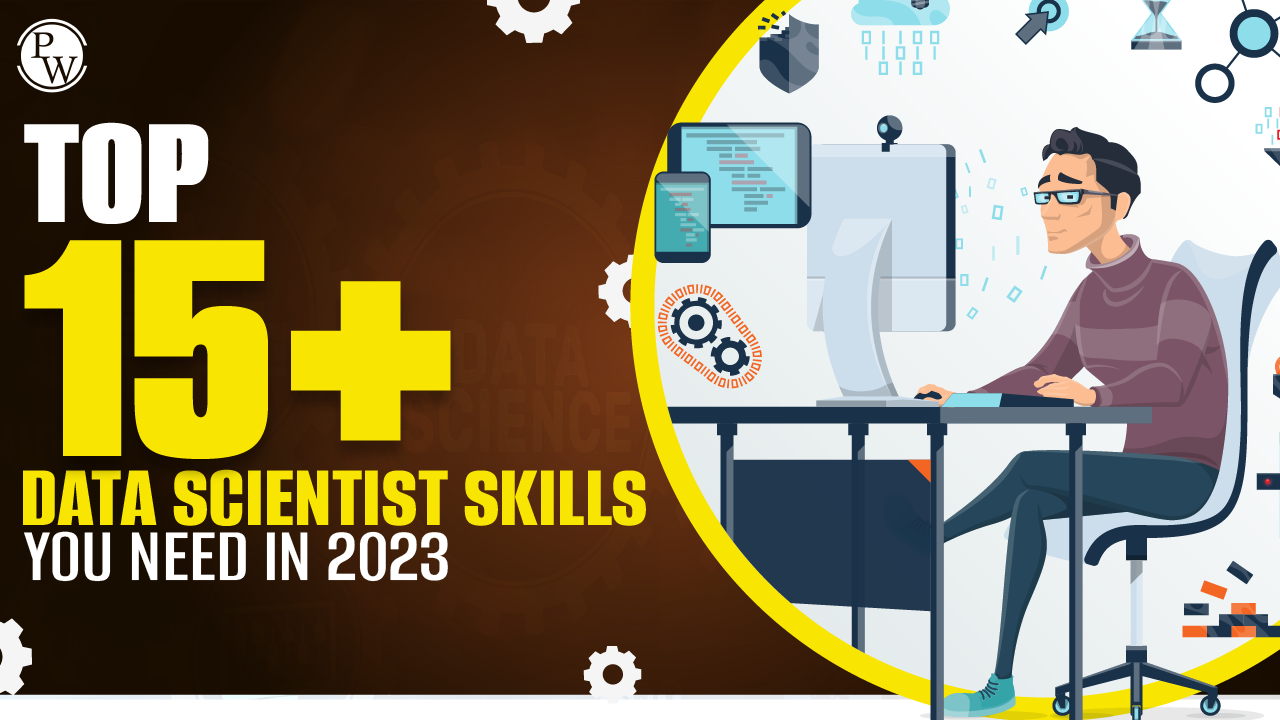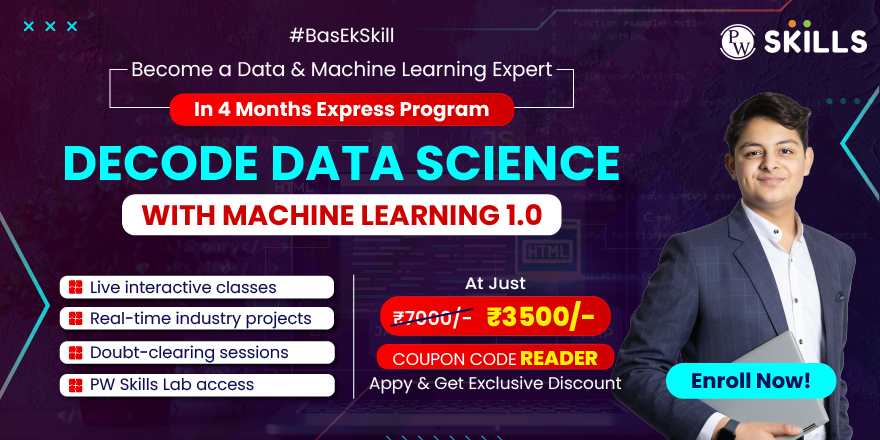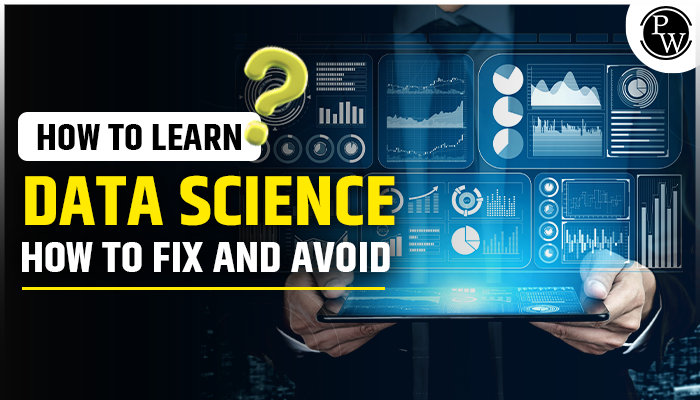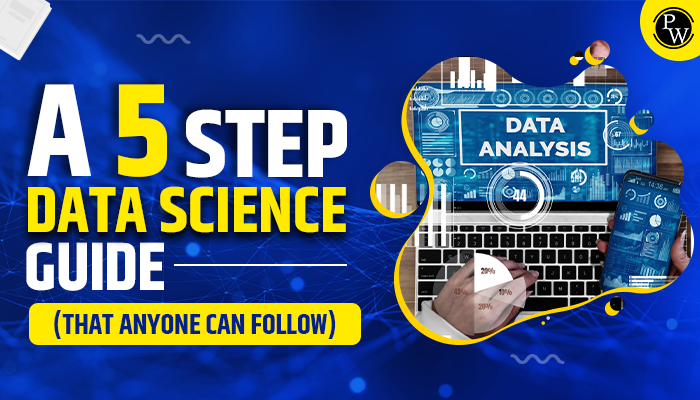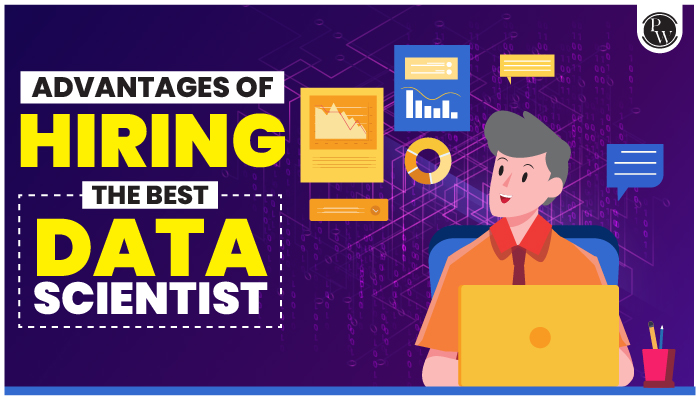Data Scientist Skills: In today’s data-driven world, the role of a data scientist has never been more crucial. With each passing year, the landscape of data science evolves, demanding that professionals in the field stay ahead of the curve to remain competitive and relevant.
As we step into 2023, the demand for data scientists continues to soar, but the required skill set is constantly shifting. If you want to build a successful career in data science, a Full-Stack Data Science course is highly recommended. In this blog, we reveal the top 30+ data scientist skills for success in data science.
30+ Data Scientist Skills You Need to Have in 2023
Here are some data scientist skills that you need in 2023:
Foundational Skills
1. Statistics and Mathematics
- Descriptive Statistics: Proficiency in descriptive statistics is essential for summarising and gaining insights from data. This includes calculating measures such as mean, median, variance, and standard deviation, providing insight into data tendencies and spread.
- Inferential Statistics: Inferential statistics entails making predictions or inferences about a population based on a sample. This involves hypothesis testing, confidence intervals, and understanding p-values, all critical for testing hypotheses and assessing the significance of findings.
2. Linear Algebra and Calculus
- Linear Algebra: Data scientists rely heavily on linear algebra, especially in machine learning. A deep understanding of concepts like vectors, matrices, matrix operations, eigenvalues, and eigenvectors is vital. Techniques like Principal Component Analysis (PCA) and Singular Value Decomposition (SVD) hinge on linear algebra.
- Calculus: Calculus is fundamental for comprehending optimization algorithms used in machine learning. Data scientists often encounter derivatives and gradients while training models. Concepts like gradient descent, pivotal in many machine learning algorithms, are rooted in calculus. Familiarity with differential and integral calculus is highly advantageous.
3. Programming
- Python: Python’s versatility and extensive library ecosystem make it the preferred language in data science. It’s used for data cleaning, visualisation, and building machine learning models. Proficiency in libraries like NumPy, Pandas, Matplotlib, Seaborn, and Scikit-Learn is essential.
- R: R excels in statistical computing and data visualisation. It’s employed for in-depth statistical analysis and crafting high-quality data visualisations. Proficiency in libraries like ggplot2, dplyr, and tidyr is valuable for data exploration and presentation.
Knowledge of SQL
4. Structured Query Language (SQL)
SQL is the universal language for querying relational databases. Data scientists use SQL to extract, manipulate, and derive valuable insights from structured data in databases. A strong grasp of SQL is vital for tasks like data extraction, transformation, and loading (ETL).
5. Data Manipulation
- Data Cleaning: Data from various sources often contains errors, missing values, and inconsistencies. Data cleaning involves identifying and rectifying or eliminating these issues to ensure data quality. Techniques may include imputation, outlier handling, and standardisation.
- Feature Engineering: Data scientists create new features from existing data to enhance model performance. Feature engineering entails selecting relevant features, transforming variables, and creating interactions between variables, significantly impacting model accuracy.
6. Working with Structured and Unstructured Data
- Structured Data: Structured data, organised in tables and databases, is relatively straightforward to work with. Data scientists use SQL and data manipulation libraries to handle structured data, perform aggregations, and run analytical queries.
- Unstructured Data: Unstructured data, such as text, images, audio, and video, demands specialised techniques. Natural language processing (NLP) is employed for text analysis, while image processing methods, like convolutional neural networks (CNNs), are used for image data.
Advanced Data Analysis
7. Machine Learning
- Supervised Learning: Data scientists must master supervised learning, training models with labelled data for predictions and classifications. This involves techniques like linear regression, logistic regression, decision trees, support vector machines (SVM), and k-nearest neighbours (K-NN).
- Unsupervised Learning: Unsupervised learning handles data without labels. It involves tasks like clustering and reducing dimensions. To excel, you need mastery of K-means clustering, hierarchical clustering, and principal component analysis (PCA). These techniques help in segmenting data and reducing its complexity.
- Deep Learning and Neural Networks: Deep learning, a subset of machine learning, gains acclaim. Proficiency in deep neural networks, CNNs for images, RNNs for sequences, and transfer learning is essential. Mastery of TensorFlow and PyTorch, along with skills in natural language processing, computer vision, and reinforcement learning, is vital.
8. Data Visualization
- Matplotlib, Seaborn, Tableau: Data visualisation is vital for conveying insights. Proficiency in tools like Matplotlib and Seaborn for Python is essential for customizable and programmatic data visualisation. Expertise in Tableau, a leading data visualisation tool, is valuable for interactive dashboards.
- Creating Compelling Data Visualisations: Beyond tool proficiency, data scientists should understand best practices. This includes selecting appropriate chart types, clear axis labels, judicious use of colour, and ensuring accessibility for a broad audience. Effective data visualisation should also narrate a coherent and persuasive story.
9. Big Data Technologies
- Hadoop and Spark: In the age of big data, data scientists need familiarity with technologies like Hadoop and Spark. Hadoop offers an ecosystem with Hadoop Distributed File System (HDFS) and MapReduce for storing and processing extensive datasets. Apache Spark, a powerful data processing framework, provides distributed computing capabilities. Proficiency in Spark’s Resilient Distributed Datasets (RDDs) and DataFrames is crucial for efficient handling of vast datasets.
- Distributed Computing for Large Datasets: Managing large datasets requires parallelization and distributed data processing expertise. Data scientists should be skilled in distributing tasks across machine clusters using Spark, enabling efficient data analysis. Proficiency in tools like HIVE, allowing SQL-like querying on big data, is advantageous for extracting insights from substantial datasets.
Domain Knowledge
10. Industry Expertise
- Healthcare: Data scientists in healthcare must know medical terminology, regulations, and healthcare delivery intricacies. This enables them to decipher patient records, clinical trials, and medical research data, ensuring ethical handling and life-saving predictions.
- Finance: Financial data scientists need to grasp financial instruments, market dynamics, trading strategies, and risk management. Understanding economic indicators’ impact on the market and financial modelling complexities is vital for effective decision-making and risk assessment.
- E-commerce: E-commerce data scientists must fathom online shopping behaviours, inventory management, and customer segmentation. Their expertise improves user experiences, optimises supply chain logistics, and boosts conversion rates. It’s vital for identifying customer behaviour patterns.
- Marketing: Data scientists in marketing should be well-versed in consumer behaviour, advertising strategies, and marketing metrics. With profound knowledge of marketing channels and customer segments, they can develop targeted campaigns, allocate ad budgets wisely, and measure ROI.
Also check: Data Science for Beginners
11. Business Process Understanding
- Customer Insights: Domain knowledge helps understand the entire customer journey, touching on customer encounters, segmentation, and personalised recommendations. Data scientists with this knowledge enhance customer experiences and retention.
- Operational Efficiency: Knowledge of business operations, supply chains, and logistics is crucial. Data scientists with this knowledge identify bottlenecks, inefficiencies, and cost reduction opportunities, leading to operational efficiency and cost savings.
- Market Trends: Staying informed about industry trends and the competitive landscape is vital. Data scientists with domain knowledge help companies spot emerging opportunities and threats, providing insights on resource allocation and staying competitive.
12. Translating Insights into Action
- Problem-Solving: Domain knowledge lets data scientists identify and define industry-specific problems. They use technical expertise for data-driven solutions, leading to more effective problem-solving.
- Customised Solutions: Understanding industry challenges and goals allows data scientists to tailor their data-driven solutions to meet specific business needs, increasing the relevance and effectiveness of their recommendations.
- Cross-functional Collaboration: Effective communication is crucial in data science. Domain expertise facilitates communication with professionals from different departments, making it easier to explain findings, justify recommendations, and collaborate on solutions aligning with broader business objectives.
Data Engineering
14. ETL (Extract, Transform, Load) Processes
- Extraction: Retrieve data from various sources like databases, APIs, logs, and cloud services. Proficiency in data extraction methods and tools is vital.
- Transformation: Prepare data for analysis by cleaning, aggregating, and normalising it. Proficiency in scripting languages and tools is crucial.
- Loading: Move transformed data to storage systems, like data warehouses or data lakes. Understand data storage technologies and design efficient data pipelines.
15. Data Warehousing
- Efficiently store and manage large data volumes for analytics. Understand data modelling, schema design, and various data warehousing solutions.
- Familiarity with options like Amazon Redshift, Google BigQuery, and Snowflake is essential.
16. Database Management and Optimization
- Manage databases, ensure data integrity, and handle backups and access controls.
- Optimise databases for efficient queries through techniques like indexing and partitioning.
- Work with NoSQL databases for unstructured or semi-structured data.
Communication Skills
17. Data Storytelling
Data storytelling entails presenting data and insights in a narrative form, simplifying comprehension. To excel:
- Know Your Audience: Customise your message based on the audience’s comprehension level. For executives, emphasise high-level insights; for technical teams, delve into specifics. Understanding your audience ensures relevant and informative delivery.
- Visual Aids: Employ data visualisations like charts, graphs, and infographics to enhance clarity and memorability. Opt for the right visualisation type, simplifying intricate concepts and making data digestible.
- Narrative Structure: Construct a compelling narrative guiding the audience from the problem to the solution. Storytelling contextualises data, making it relatable and engaging.
- Simplicity: Avoid jargon and technical terms. Keep explanations straightforward for clear understanding and actionable insights.
18. Effective Visualisation and Reporting
Effective data communication through visualisations and reports involves:
- Clarity: Ensure visualisations are easily understood with labelled axes, legends, and effective colour coding. Clutter-free visuals accurately convey your message.
- Relevance: Choose visuals pertinent to your data and insights, avoiding information overload. Each element should serve a purpose for better comprehension.
- Consistency: Maintain a consistent style in reports, keeping the focus on content and enhancing professionalism and credibility.
- Interactivity: Employ interactive tools when necessary, allowing audiences to explore data. Interactivity enhances engagement and insight, enabling personal conclusions.
Tools and Libraries
19. Data Science Libraries
- NumPy: It’s a fundamental Python library for numerical computation, supporting arrays, matrices, and mathematical functions, essential for data manipulation and analysis.
- Pandas: Another indispensable Python library, it simplifies structured data management with its DataFrame structure and provides tools for data cleaning and transformation.
- Scikit-Learn: A potent Python library for machine learning, offering a variety of algorithms for classification, regression, clustering, and more, along with model selection and evaluation tools.
- TensorFlow and PyTorch: Crucial for creating and deploying neural networks, TensorFlow is versatile and ideal for production, while PyTorch excels in ease of use and dynamic computation graph.
20. Version Control (Git)
Git, a version control system, is vital for collaborative code management. Data scientists should be well-acquainted with Git to monitor code changes, collaborate effectively, and maintain a clear project history.
21. Cloud Platforms
Leading cloud providers like AWS, Azure, and Google Cloud Platform deliver scalable infrastructure and services for data science. Proficiency with these platforms is necessary for deploying data pipelines and machine learning models in the cloud.
Also check: Data Scientist Job Description: Role, Responsibilities
22. Docker and Kubernetes
These tools for containerization and orchestration are crucial for creating reproducible and scalable data science environments. They simplify the deployment of complex applications and ensure consistency across various platforms.
Ethical Skills
23. Data Privacy and Security
- Comprehending Data Privacy Rules: Data scientists must master data privacy laws like GDPR, CCPA, and other specific regulations. They must guarantee that data handling adheres to these rules.
- Data De-Identification: Understanding how to safeguard individuals’ privacy through data anonymization is crucial. This involves methods like pseudonymization, data masking, and encryption.
- Transparent Consent: Ethical data scientists should endorse clear and informed consent from individuals whose data is used. Communicating the purpose of data collection and obtaining permission is vital.
24. Bias and Fairness in Machine Learning
- Recognizing Bias: Data scientists need to acknowledge bias in data, algorithms, and models. Biassed data or algorithms can perpetuate discrimination and inequality. Identifying and reducing bias is their duty.
- Fairness Metrics: Understanding fairness measurements like disparate impact and equal opportunity is crucial. Data scientists must construct models that are fair and just, not favouring any particular group.
- Ethical AI: Ensuring AI and machine learning models are created with ethical principles is a foundational responsibility. This includes avoiding models that could be misused or amplify harmful biases.
25. Responsible AI Practices
- Model Explanation: Data scientists must clarify their machine learning models’ decisions. Techniques like LIME and SHAPE provide insights into model predictions.
- Model Testing and Validation: Thorough testing and validation of models are essential to guarantee they function as intended and do not cause unintended harm. Stress-testing models is necessary to uncover vulnerabilities.
- Algorithm Transparency: Data scientists should push for transparency in algorithms they use, particularly in areas with significant impacts like credit scoring or hiring.
Soft Skills
26. Critical Thinking and Problem-Solving
- Analytical Acumen: Data scientists often grapple with intricate, multifaceted dilemmas. The ability to dissect these issues into manageable components and scrutinise them critically is imperative. Crafting a structured problem-solving approach aids in deciphering extensive data sets and discovering valuable insights.
- Innovative Solutions: Many situations lack a solitary correct answer. Employing creativity in problem-solving can yield innovative solutions and fresh perspectives. A willingness to consider unconventional ideas and methods can distinguish you as a data scientist.
- Hypothesis Evaluation: The scientific method is a foundational tool for data scientists. Constructing hypotheses, designing experiments, and rigorously testing them permits drawing meaningful inferences from data.
27. Adaptability
- Flexibility: The data science domain undergoes continual transformation. Novel technologies, tools, and techniques emerge regularly. Being receptive to learning and adapting to change is indispensable. Whether it involves embracing new programming languages, data storage solutions, or machine learning algorithms, adaptability ensures your skill set remains current.
- Resilience: Data science projects may pose challenges and might not always yield anticipated results. Being resilient and capable of persevering through setbacks and failures is vital. Such experiences often foster valuable lessons and enhance skills.
- Agility: Data scientists must swiftly pivot in response to new data, stakeholder feedback, or evolving project requirements. The ability to reorient focus and priorities efficiently is a valuable trait.
28. Continuous Learning
- Inquisitiveness: Data science is an ever-evolving field, and maintaining curiosity about novel developments and trends is paramount. Whether it involves perusing research papers, engaging in online courses, or attending conferences, an unrelenting thirst for knowledge will keep you on the cutting edge of your profession.
- Self-Motivation: In a discipline that often demands self-directed learning, sustaining self-motivation is indispensable. The innate drive to explore new concepts, refine skills, and tackle challenges defines accomplished data scientists.
- Professional Advancement: Consider allocating dedicated time for professional development. This might encompass joining data science communities, networking, or seeking mentorship opportunities. Establishing a support network and seeking guidance from seasoned data scientists can expedite your growth.
Data Science Workflow
29. Project Management
- Problem Identification: Start by clearly defining the issue to tackle in a data science project. Understand the business context, project goals, and the data-related questions you need to answer.
- Data Collection: Gather pertinent data from various sources, like databases, APIs, or web scraping. Ensure data quality by collecting clean, complete, and accurate information.
- Exploratory Data Analysis (EDA): Delve into the data to grasp its characteristics, patterns, and relationships. EDA helps spot outliers, missing data, and potential insights guiding your analysis.
- Feature Engineering: Modify and enhance data features to make them more suitable for modelling. This includes creating new variables, encoding categorical data, and managing missing values.
- Modelling: Choose the right algorithms and models based on the specific problem. Options may include regression, classification, clustering, or deep learning. Train and assess these models.
- Model Evaluation: Measure the model’s performance using appropriate metrics. This can involve cross-validation, adjusting hyperparameters, and fine-tuning the model for optimal results.
- Interpretation and Insights: Understand the model’s results and extract actionable insights. Here, your domain knowledge is invaluable for translating data findings into practical recommendations.
30. Experimental Design
- Hypothesis Formulation: Frame your data science project with hypotheses. What are your expectations, and how will they impact the problem you’re solving?
- Data Splitting: Split your dataset into training, validation, and test sets. This aids in model evaluation and ensures that your model generalises effectively to unseen data.
- A/B Testing: When optimising a product or process, A/B testing can be a potent technique to assess the impact of changes on user behaviour or business outcomes.
31. Model Deployment and Maintenance
- Deployment: Once you’ve chosen the final model, deploy it into a production environment. This often involves integrating the model into an application or system, enabling real-time predictions.
- Monitoring: Continuously oversee the performance of deployed models. Over time, data drift and concept drift may occur, affecting model accuracy. Implement mechanisms to detect and address these issues.
- Maintenance: As new data becomes available or business needs evolve, models may need updates, retraining, or even replacement. Regularly maintain and enhance your models to keep them effective.
Conclusion
In the dynamic field of data science, adaptability and a relentless quest for knowledge are your most valuable assets. In 2023, the role of data scientists continues to be crucial in shaping the future. To excel in this exciting journey, your acquired skills serve as your base, but your dedication to learning and development acts as the guiding compass through the data-driven landscape of the future. Be curious, innovative, and fully embrace the data science revolution!
Also check: Top 12 Data Science Certifications That You Can Consider
FAQs
What is the role of data engineers in the data science process?
Data engineers prepare and maintain data pipelines, ensuring data is accessible and in the right format for analysis by data scientists.
Why is open-source software important in data science?
Open-source tools and libraries provide data scientists with cost-effective and collaborative solutions for their work.
How do data scientists address data privacy concerns?
Data scientists anonymize, encrypt, and secure data to protect sensitive information and ensure compliance with data protection regulations.
What is the impact of data science on various industries?
Data science is transforming industries by optimising operations, improving customer experiences, and enabling data-driven strategies for growth.
What are the key challenges data scientists face in their work?
Challenges include data quality issues, limited computing resources, and the need to balance business goals with ethical and legal considerations.

